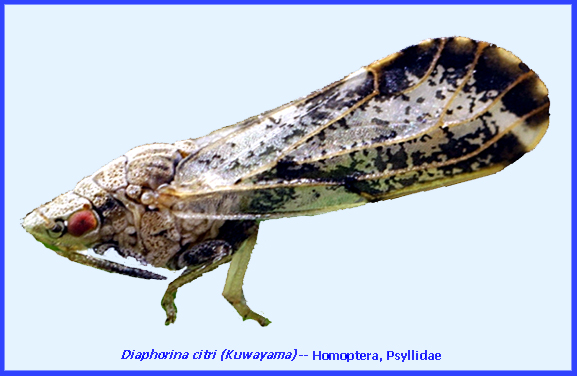FILE: <ch-124.htm> GENERAL INDEX [Navigate to MAIN MENU ]
|
ASIAN CITRUS PSYLLID Diaphorina citri Kuwayama (Insecta: Hemiptera: Psyllidae) (Contacts) ----- CLICK on Photo to enlarge &
search for Subject Matter with Ctrl/F.
GO TO
ALL: Bio-Control
Cases Attempts to control
this psyllid by the importation of natural enemies have begun in 2011, but
the exact point of origin is unclear and the probability of success is
uncertain. This is largely due to the
fact that the bite of only a single psyllid individual can inoculate the
disease-causing pathogen.
Nevertheless two parasitic wasps, Tamarixia radiata and Diaphorencyrtus
aligarhensis have been imported from northern Pakistan and liberated in
Southern California where the psyllid occurs. Tamarixia (Family: Eulophidae) is now established. It was first described in 1922 from
specimens that emerged from the Asian psyllid on lemons in Lyallpur (modern
day Faisalabad in Pakistan). Ongoing investigations are to determine its
impact on the psyllid and its adaptability to the California climate. [Further details = Asian Citrus Psyllid
and More] Without effective
natural enemies, insecticide treatments for the Asian psyllid as it advances
into Inland areas can only be a temporary halt to the invasion of this
pest. There are no geographical barriers between the Inland and coastal
areas of Southern California where the psyllid is now established, and
therefore the insect will reinvade again and again. The eradication
effort would have been more effective if it had been carried out at sites
where the pest was originally detected in the coastal areas. Also, the
psyllid, with the accompanying bacterial pathogen, has also been found in
Sacramento in packages from India, and it is doubtful that such "Innocent" mailings can ever be
halted.
5. Will the establishment of two new
parasitic wasps from India and Pakistan reduce the psyllid population low
enough to reduce the threat? The following websites also contain
information on the Asian Citrus Psyllid: http://creatures.ifas.ufl.edu/citrus/acpsyllid.htm http://www.ipmimages.org/browse/subthumb.cfm?area=123&sub=9257 http://ipm.ifas.ufl.edu/agriculture/citrus/asian.shtml http://www.californiacitrusthreat.com/asian-citrus-psyllid.html http://cisr.ucr.edu/asian_citrus_psyllid.html http://cisr.ucr.edu/blog/psyllids/hunting-for-natural-enemies-of-asian-citrus-psyllid-in-pakistan/ http://cisr.ucr.edu/blog/invasive-species/tamarixia-radiata-release-video/ http://cisr.ucr.edu/blog/news/first-release-of-tamarixia-radiata-in-california-for-the-biological-control-of-asian-citrus-psyllid/ REFERENCES: [Additional references may be found at: MELVYL
Library ] Atwal,
A. S., J. P. Chaudhary & M. Ramzan.
1970. Studies on the development
and field population of citrus psylla, Diaphorina citri Kuwayama
(Psyllidae: Homoptera). Journal of
Research Punjab Agricultural University 7: 333-338. Bindra,
O. S., B. S. Sohi & R. C. Batra. 1974.
Note on the comparative efficacy of some contact and systemic
insecticides for the control of citrus psylla in Punjab. Indian Journal of Agricultural Science 43:
1087-1088. Capoor,
S. P., D. G. Rao & S. M. Viswanath.
1974. Greening disease of
citrus in the Deccan Trap Country and its relationship with the vector, Diaphorina
citri Kuwayama. p. 43-49. In Weathers LG, Cohen M
(editor). Proceedings of the 6th
Conference of the International Citrus Virology, University of California,
Division of Agricultural Sciences. Catling,
H. D. 1970. Distribution of the psyllid vectors of citrus greening disease,
with notes on the biology and bionomics of Diaphorina citri. FAO Plant Protection Bulletin 18: 8-15. Costa
Lima, A. M. da. 1942. Homopteros. Insetos do Brazil 3: 1-327. Esc. Na. Agron. Min. Agr. Grafton-Cardwell, E E., K. E.
Godfrey, M. E. Rogers, C. C. Childers
& P. A. Stansly. 2006. Asian Citrus Psyllid. U. C. ANR Publication. 8205. Oakland, CA. Hall,
D. G. 2006. A closer look at the vector: Controlling the Asian citrus
psyllid is the key to managing citrus greening. Citrus
& Vegetable Magazine 70 (5): 24-26. Hall,
D. G., M. G. Hentz, &. R. C. Adair Jr.
2008. Population ecology and
phenology of Diaphorina citri (Hemiptera: Psyllidae) in
two Florida citrus groves.
Environmental Entomology 37: 914-924. Husain,
M. A. & D. Nath. 1927. The citrus psylla (Diaphorina citri,
Kuw.) (Psyllidae: Homoptera) Memoirs
of the Department of Agriculture India 10: 1-27. Mangat,
B. S. 1961.
Citrus psylla (Diaphorina citri Kuway) and how to control
it. Citrus Industry 42: 20. Mathur,
R. N. 1975. Psyllidae of the Indian Subcontinent. Indian Council of Agricultural Research, New Delhi. 429 pp. Miyakawa,
T, H. Tanaka & C. Matsui. 1974.
Studies on citrus greening disease in southern Japan. p. 40-42 In Weathers
L. G & M. Cohen (editors).
Proceedings of the 6th Conference of the International Citrus
Virology, University of California, Division of Agricultural Sciences. Moll,
J. N. & S. P. van Vuuren. 1977.
Greening Disease in Africa. 1977 International Citrus Congress,
Orlando, Florida, Program and
Abstracts. 95 pp. Pande,
Y. D. 1971.
Biology of citrus psylla, Diaphorina citri Kuw.
(Hemiptera: Psyllidae). Israel
Journal of Entomology 6: 307-310. Polek, M, G. Vidalakis & K. E.
Godfrey. 2007. Citrus Bacterial
Canker Disease and Huanglongbing (Citrus Greening). U. C. ANR
Publication. 8218. Oakland, CA. Raychaudhuri,
S. P. Nariani, S. K. Ghosh, S. M. Viswanath & D. Kumar.
1974. Recent studies on citrus
greening in India. p. 53-57. In Weathers LG, Cohen M
(editor). Proceedings of the 6th
Conference of the International Citrus Virology, University of California,
Division of Agricultural Sciences. Rust, M. K. & D-H. Choe. 2012. Pest Notes: Ants. U. C. ANR Publication 7411. Oakland, CA. Schwarz,
R. E., L. C. Knorr & M. Prommintara.
1974. Citrus greening disease in Thailand. FAO Technical Document No. 93: 1-14. U.S.
Dept. of Agriculture. 1959. Insects not known to occur in the United
States. Citrus
psylla (Diaphorina citri Kuwayama). No. 88 of Series. Cooperative Economic Insect Report 9:
593-594 Wooler,
A, D. Padgham & A. Arafat.
1974. Outbreaks and new
records. Saudi Arabia. Diaphorina citri on citrus. FAO Plant Protection Bulletin 22: 93-94. |
